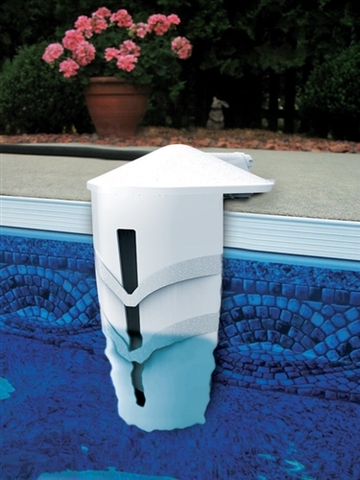Lifehack: Keeping the pool full with a smart watering timer

In dry California, with no rain from May to October, we don't just get fires. If you have a pool, you have to add water to it regularly.
By some measure, the easiest way to do this is with an automatic pool filler, which uses a float (not too unlike a toilet tank) to keep the water at constant level. This is very straightforward, and costs around $60 to $100. However, when mine started leaking, I considered another option, namely the computer timed water valves people use to control sprinklers.
The simple mechanical nature of a float switch seems like an obvious win. It adjusts to rain, evaporation and other water loss automatically. It uses no electricity. But it comes with some downsides:
- As noted, you can get leaks, in fact that's pretty easy to get, at the hose interface or inside the unit.
- You need a mount to keep it steady on the size of the pool, so it is somewhat large
- You must keep a rubber hose at pressure (though you don't need full pressure) all the time, which also eventually can lead to failures.
- When you swim, waves bob the float up and down, and it makes noise, sending bursts of water into the pool on every wave.
- You don't get a sense of how much water you are putting in the pool, so if you get a leak, you just add more, which is good and bad.
It turns out that simple sprinkler timers have some advantages
- They are cheaper -- $30 for a basic decent one, $50 for one that does bluetooth. * The valve is now right on the water outlet, so the hose does not run under pressure.
- While I have not done it, you could run just a very small hose at lower pressure into the water, for something much less intrusive. If you send full pressure the hose will flail around and must be secured, but that can done above.
- One disadvantage is you have to change batteries every year.
The big issue, of course, is that you are not matching the water flow to the level of the pool. I had a plan for that, but to my shock, the very first setting I tried, a few minutes a day, is keeping the pool at constant level right now. As we get into the colder rainy season, I will have to turn it down. Even so, I suspect I will only have to make a few adjustments per year. It's also possible to get it almost right and then use the traditional manual fill method to bring it up a bit once per month or so.
Then I imagined what you might do as a deliberate product. Namely, one could make a sprinkler timer that knows to adjust flow based on the season. That would probably get it 90% right with very little minor adjustment.
But if you have bluetooth to a phone, the phone could, from time to time relay commands to the valve, because it will know how sunny and warm it has been and how much rain there has been or is forecast, and give it adjustments automatically. You want good security -- IoT water valves are a tasty target, so ideally the device would only take signed firmware, and would refuse commands from the phone to add more than a certain maximum number of gallons, or less than a minimum.
I suspect such a system would be so good as to only need adjustment about as often as it needs new batteries. And it would have all the advantages listed above.
The alternative would be to include a small hose with an electronic water level sensor in it for perfect adjustment with no bluetooth needed. This would just be a small strip running along the hose that detects if water has risen above the sensor. That's trivial and cheap and could also be added to any existing hose, or just mounted in mostly invisible way on the side of the pool or in the filter basket.
Doing it by hand
Of course, many people just keep their pool level by hand, when adding chemicals or cleaning it. However, if you have a pool service that does that once/week, as many people do, they may not be able to add enough water during their 15 minute once/week visit. Because I used to travel for long periods before Covid -- sometimes for months -- doing it by hand was not an option for me, and I would have to ask neighbours to come over and do it for me.
Another solution, which I think I will do, is to use my old leaky float filler at the end of the timed hose. This will always add the right amount of water, and the leak will drip for only a few minutes per day. The hose won't be under pressure, and the valve won't trigger while we swim. This is a good use for an old and leaky filler, I would not buy a new filler just to do this.








Comments
Ross
Fri, 2020-10-02 14:36
Permalink
Fix for the wave-squirt problem
Close off that long slot except for a small opening at the bottom. Basically putting a low-pass filter on the float chamber. Also keeping the opening small and below the surface would help keep out debris.
brad
Sat, 2020-10-10 12:28
Permalink
That design
Yes, the design pictured could be improved, though I still think people splashing and playing would have issues with it turning on or off, but with less frequency using the small input. It doesn't alter the other flaws, in particular the issue of having the valve at the end of a hose rather than on the main pipe.
Add new comment